- Home
- Various Articles - Inclusion and Diversity
- The Cry for Inclusiveness and Diversity: Can There be Light at the End of the Tunnel?
The Cry for Inclusiveness and Diversity: Can There be Light at the End of the Tunnel?
Elaine Hodgson is a trainer, consultant and materials writer. She holds an MA and a PhD in Applied Linguistics and a DELTA (M1) certificate. She is also a tutor and supervisor in the Distance MA in TESOL for the University of Birmingham (UK).
Viviane Kirmeliene is an ELT consultant, editor and materials writer. She holds a BA in English from the University of Sao Paulo and the Cambridge ICELT. As an editor and writer, she has worked on several projects in Brazil and abroad.
The story of Franklin and Charlie Brown
Many of us will be familiar with Charlie Brown, the iconic character created by Charlie Schulz in 1948, who has been voicing so many of our existential concerns for so many years. Maybe not all of Charlie Brown’s fans know Franklin, the black character introduced by Schulz 20 years later. It had been eleven days since Martin Luther King had been assassinated when Harriet Glickman, a teacher in the suburbs of Los Angeles, California, wrote to the already famous cartoonist suggesting he created a black character so as to help fight intolerance, hate and violence (FLORIDO, 2015; LEI, DELAHOUSSAYE, 2018). She thought that promoting the idea of friendship between people of different ethnicities could have a positive effect. Harriet’s proposal can sound indisputable today, but it did not sound so obvious in the highly segregated United States of the 60’s. Schulz replied to her letter and, not without hesitation, decided to include the first black character in a comic strip, in which Franklin found Charlie Brown’s lost ball on the beach and then started making sand castles with his new friend. Schulz’s decision was praised by some, but also raised several protests. Franklin was one of the very first black characters in a comic strip who was shown in a positive light and he still remains a rare example of ethnic representation in printed media even over fifty years after his first appearance.
The story of how Franklin was created for the Peanuts comic strips illustrates an issue – the ethnic one – among many diverse and urgent matters of diversity and inclusiveness we must discuss as educators. In this article, we will focus on two of these matters: Why is there still so little variety in representation in teaching materials, when the cry for diversity has been there for so long? What can be done to ensure all of our students feel represented in the classroom?
What happens in ELT material goes beyond PARSNIPs
If you have any ELT coursebook at hand, we would like to ask you to stop reading this article now and browse through its pages, paying special attention to the images depicted, be they photos or illustrations. Observe if and/or how the items listed below are represented:
- ethnicities other than white
- family structures
- women
- older people
- overweight people
- people wearing glasses
- people with any sort of mental or physical disability
If you accepted our challenge, you have probably found out that the aforementioned categories are either absent or misrepresented in books. It is important to point out that, if you do not identify with any minority or underprivileged groups, it is very likely that you have never paid much attention to how and how often different people and contexts are depicted (or not) in coursebooks.
As far as family structures are concerned, the most common pattern we see in coursebooks is still the so-called “traditional” nuclear family, consisting of mother, father and children – usually a boy and a girl. Grandparent families, single parents and same-sex parenting, to name a few family structures, are more often than not ignored in coursebooks, although we have all met them in our social circles – if you are a teacher, you may also know students who are part of “non-traditional” family structures. Still, most mainstream coursebooks fail to make this reality clear.
Another point in which there is a clear lack of inclusiveness and diversity has to do with personal image. Think of a particular class you teach and try to remember students who wear glasses or who are overweight. Now think of the coursebook you browsed through. Would you say that these students identify with the people depicted in the beautiful stock photos and commissioned illustrations? Do you feel represented yourself?
If we advance the discussion of the issues above from images to topics, we will probably come to similar conclusions. What we all know is that certain topics, no matter how pervasive they are in real life, are utterly ignored in coursebooks. However, we have come to realize that the “forbidden” topics and images go far beyond the notorious PARSNIPs.
If you are not familiar with the acronym PARSNIP and what it means when it comes to coursebooks, we can say that PARNIPS basically refer to taboo topics (and also to their visual representation) which are usually avoided in coursebooks for commercial reasons:
Politics
Alcohol
Religion
Sex
Narcotics
Isms (such as in socialism)
Pork
There are several extremely interesting articles discussing PARSNIPs in ELT and also on how these topics can be sensibly tackled in the classroom (JC SMITH et. al. 2015; HOWARD, et. al. 2016). However, when looking into coursebooks with a keener eye, we can easily notice that in terms of “taboo”, we would need to add some other letters to the PARSNIP acronym. Even commonplace or everyday situations in our multifaceted world are avoided: overweight people and single-parent families are just two examples from the list we mentioned before. Such absences or misrepresentations contribute to perpetuate a culture of stereotypes and sterilised normality, where inclusiveness and diversity are merely vague and abstract concepts that we expect to be dealt with by someone else and preferably far away from our classrooms.
Nevertheless, if we believe that, as educators, we play a role in helping our learners become critical thinkers and critical citizens, the lack of inclusiveness and diversity in the content used in our English classes should be bothering us. Can the status quo be changed so that we can have more inclusive and diverse lessons?
What has been done for inclusiveness and diversity in ELT coursebooks
If you are a teacher working in Brazil, you have probably heard of the Programa Nacional do Livro Didático (PNLD), the most important coursebook tender in Brazil. In this programme, the federal government analyses coursebooks for teaching subjects from the curriculum. Those publications that meet the rigorous standards set by the Ministry of Education are approved, purchased according to teachers’ choices and then used in public schools all over the country. The first PNLD coursebooks for English classes were purchased in 2011, even though the programme had been created in 1985 (SARMENTO, 2016). According to Semis (2017), in 2017, over 152 million books were being used by basic education public schools in Brazil.
As mentioned before, these coursebooks have to follow strict guidelines in order to be approved. For English materials, the tender guidelines include, among other relevant criteria, representation of cultural and ethnic diversity in Brazil and in the world. This embraces respectful, diverse and pervasive representation of families, ethnic groups (including indigenous and black people, who make up a vast percentage of the Brazilian population) women and older people, to name a few, and also inclusion of topics that have somehow become controversial in some contexts, such as climate change and human rights. While it is true that some of the approved coursebooks in PNLD choose to be more, or less, critical of certain topics, it is undeniable that the compulsory presence of themes and images that are uncommon in mainstream coursebooks represents a huge leap forward for inclusion and diversity at public schools.
At this point, it is important that we highlight the fact that failing to include certain topics and images is linked to perceived society values and beliefs. For instance, almost ten years ago Thornbury (2010) had already pointed out that inclusion of certain topics in coursebooks is not necessarily related to lack of good will on the part of publishers but more about how consumers are going to perceive such topics. He explains
“In ELT publishing the ‘verbal hygiene’ that publishers impose on themselves is motivated less by a wish to assert multicultural values than by the need to avoid offending potential markets.”
Given that Charlie Brown and Franklin’s friendship started over 50 years ago and that racism and lack of representation are still existent in printed material, we may deduce that changing our views to accommodate new values and beliefs is a process which is usually slower than minority groups would like it to be and which will, very often, cause pain, outrage, hate and even verbal and physical violence. Thus, we know that if we simply wait for society – and coursebooks – to change on their own, without any kind of encouragement or even enforcement (for example, by making racism a crime), we may wait endlessly. When coursebook authors and publishers have diversity and inclusiveness representation standards that must be followed, however, the whole school community is required to think about the diversity that surrounds us and is compelled to question the stereotyped ‘normality’ so commonly seen in coursebooks.
PNLD is, unquestionably, a turning point in the development of ELT materials, as well as a brave initiative. In the following section of this article, we will briefly explain and exemplify how some coursebooks used in public schools in Brazil have dealt with four issues that are usually “taboo” in mainstream ELT: ethnical representation, families, older people and the role of women in society.
Ethnical representation
One of the demands of PNLD is representation of ethnicity. It is mandatory that a variety of ethnicities be presented in a positive and respectful way. In approved coursebooks, there are also tasks to help students recognise and critically analyse the relevance of different peoples in the world and also to critically think about the role and importance of ethnic minorities. When we think about the Brazilian context, it seems natural that indigenous and black people are present in coursebooks, which means the need for a more balanced approach to representation. The samples taken from PNLD coursebooks are examples of how authors and publishers worked with ethnic representation in different coursebooks:
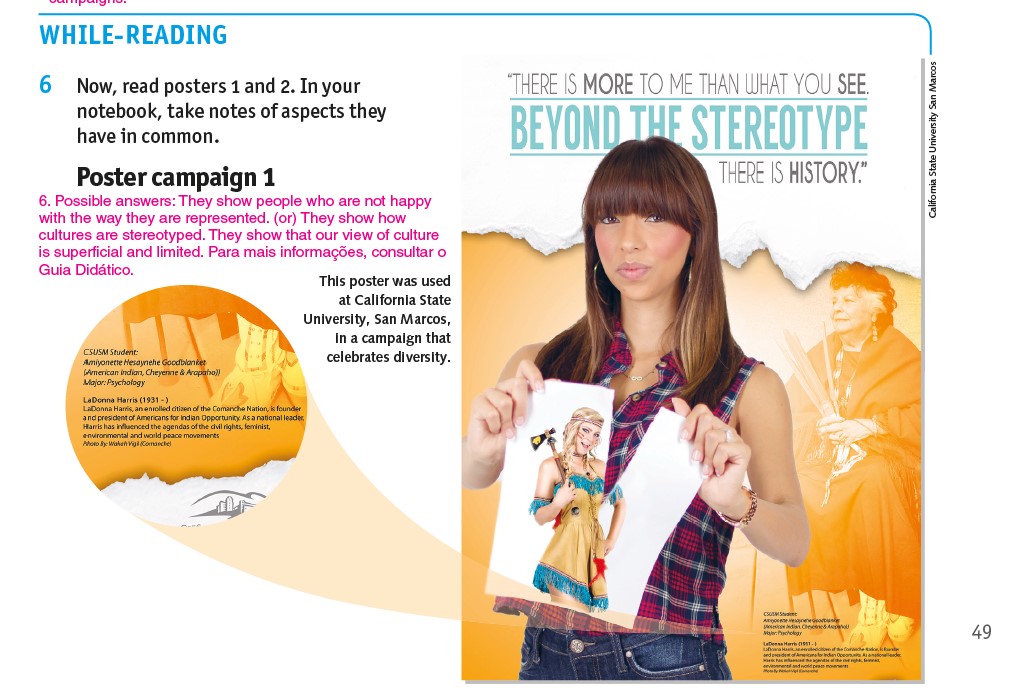
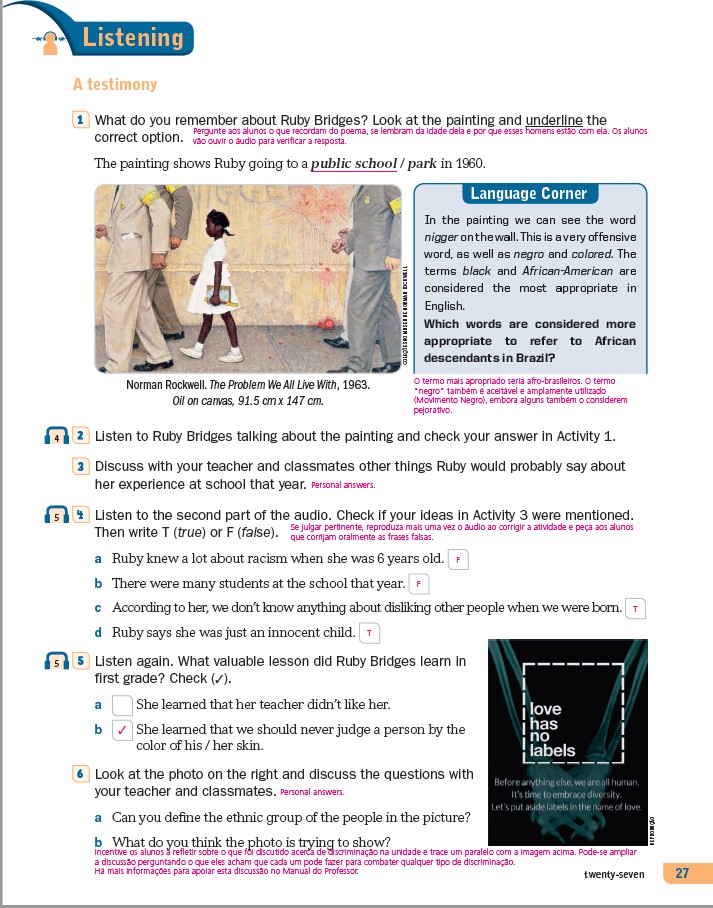
Families
Although the PNLD guidelines do not directly make reference to different family structures (VENTUROSO, 2017), they do reinforce the need to promote representation and a positive attitude towards different family structures present in students’ lives. As a consequence, different types of family are more likely to be found in coursebooks aimed at Brazilian public schools than in mainstream coursebooks, used in private language schools, as seen in the samples below:
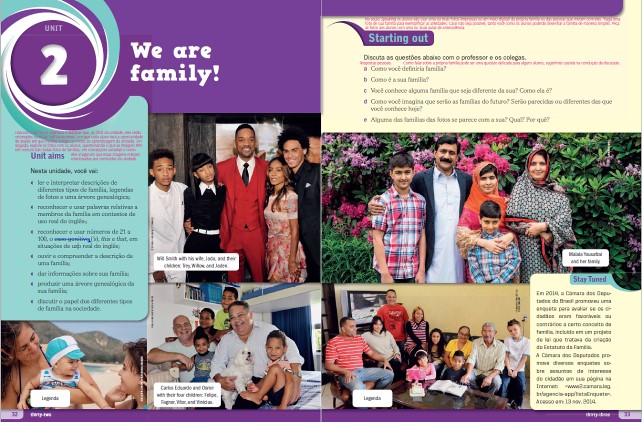

Women
As mentioned before, the PNLD is concerned about representation of different ethnic, social and cultural contexts and also about minorities. When it comes to the representation of women, the guidelines are usually very specific. For instance, the guidelines for PNLD 2017 state that, to be approved, coursebooks should
“positively promote the image of women, considering their participation in different jobs, professions and spaces of power, reinforcing their visibility and social protagonism”. (MEC, 2015, p. 40)
Following the guidelines means that authors and publishers of PNLD coursebooks must deal with these issues in different lessons, as seen in the samples below
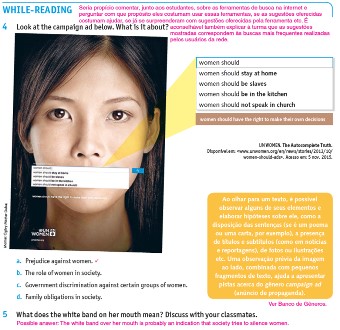
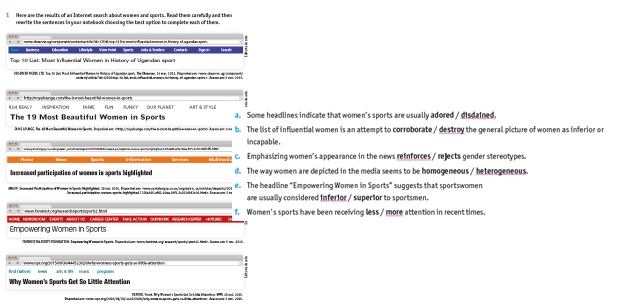
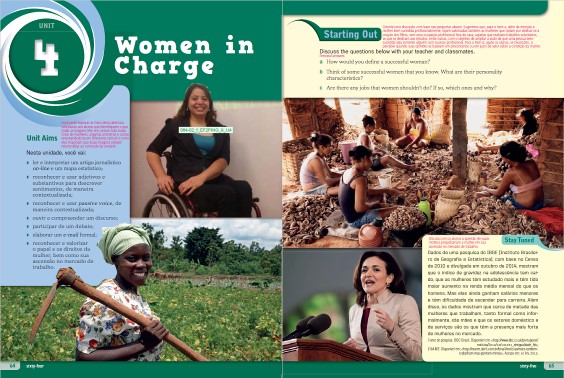
Older people
Older people are hardly ever represented in a positive way in coursebooks and sometimes are not even represented at all. Besides, although they are sometimes depicted in photos and illustrations (particularly in units used to teach past tenses), coursebooks rarely deal with the topic of getting old. Again, the samples below extracted from PNLD coursebooks indicate that not only is it possible to discuss ageing as a natural and positive aspect of life, but that it is also necessary to do so in a society whose life expectancy has been increasing in recent years.
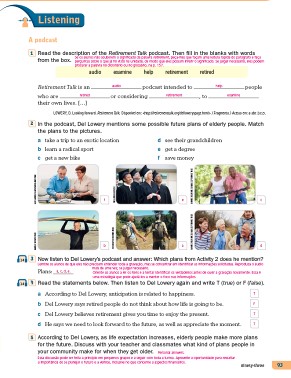
Conclusion
This article aimed to highlight some topics that are often avoided in mainstream coursebooks, but that are approached by PNLD coursebooks, which are textbooks approved and distributed by the Brazilian federal government to students in basic education in public schools. In recent years, this extremely important programme has been helping inclusiveness and diversity become incorporated in school life. It is important to point out again that this has happened fundamentally because the strict guidelines for such coursebooks specifically state that diversity and inclusiveness must be explicitly approached. Embracing inclusiveness and diversity in printed material has been a desire, an expectation and a demand for many years, as the anecdote about Charlie Brown and Franklin shows us. Nevertheless, it is very likely that ELT and educational publishers in general will only take action if there are public policies requiring them to do so.
The purpose of the samples in this article is to show that PNLD has proven that having diversity and inclusiveness in ELT materials is feasible. Given the chance to analyse PNLD books, one will also see that much more can be done and topics that are uncommon and that can be controversial, such as immigration, global warming, mental health and domestic violence are carefully and critically approached. In short, we believe it is possible to say that there is light at the end of the tunnel, but reaching it requires attention, persistence and vigilance. When it comes to diversity and inclusion in society, considerable progress has been made, but unfortunately we are far from being able to take issues such as gender equality for granted. As citizens and educators, it is our duty to remain alert and to keep demanding that our students have the opportunity to see themselves and their communities represented in ELT materials and that they have the chance to learn from different people who belong to different contexts in a positive and respectful way.
References
Dias, R.; Hodgson, E.; Santos, D.; Mott-Fernandez, C. (2015) Team Up. Cotia: Macmillan.
Florido, A. (2015) How Franklin, the black ‘Peanuts’ character, was born. https://www.npr.org/sections/codeswitch/2015/11/06/454930010/how-franklin-the-black-peanuts-character-was-born
JC Smith, M. et. al. (2015) Parsnips in ELT: Stepping out of the comfort zone (Vol. 1). http://research.sabanciuniv.edu/27130/1/parsnips-in-elt-stepping-out-of-the-comfort-zone-vol-1.pdf
Howard, R. et. al. (2016) Parsnips in ELT: Stepping out of the comfort zone (Vol. 2). http://research.sabanciuniv.edu/29356/1/parsnips-in-elt-stepping-out-of-the-comfort-zone-vol-2.pdf
Kirmeliene, V.; Pereira, C.; Hodgson, E.; Ladeia, R. (2016) Circles. São Paulo: FTD.
Lei, C; Delahoussaye, J. (2018)‘Peanuts’ first black character turns 50. https://www.npr.org/2018/07/29/633544308/peanuts-character-franklin-turns-50?t=1558343306979
MEC (2015) PNLD 2017 – Edital de convocação para o processo de inscrição e avaliação de obras didáticas para o Programa Nacional do Livro Didático.
SARMENTO, S. (2016) ReVEL na Escola: Programa Nacional do Livro Didático de Língua Estrangeira. ReVEL, v. 14, n. 26. http://www.revel.inf.br/files/f87762bb49975db7eff1d09ac87967c2.pdf
Semis, L. (2017) Entenda o PNLD e saiba quais são os livros didáticos mais distribuídos em 2017. Nova Escola. https://novaescola.org.br/conteudo/4864/entenda-o-pnld-e-saiba-quais-sao-os-livros-didaticos-mais-distribuidos-em-2017.
Thornbury, S. (2010) T is for Taboo. An A-Z of ELT. https://scottthornbury.wordpress.com/2010/06/27/t-is-for-taboo/
Venturoso, B. (2017) Discursos, identidades e representações de família em livros didáticos da educação básica. MA dissertation. file:///Users/elainehodgson/Downloads/2017_BarbaraVenturoso.pdf
Please check the Methodology and Language for Secondary course at Pilgrims website.
Please check the Teaching Advanced Students course at Pilgrims website.
Please check the How to Motivate Your Students course at Pilgrims website.
The Cry for Inclusiveness and Diversity: Can There be Light at the End of the Tunnel?
Elaine Hodgson, Brazil/UK;Viviane Kirmeliene, Brazil